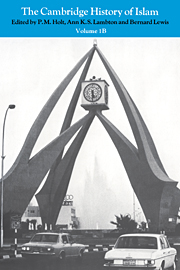Book contents
7 - Economic and social change
from Part IV - The central Islamic lands in recent times
Published online by Cambridge University Press: 28 March 2008
Summary
In the second and third quarters of the twentieth century the Muslim countries of the Middle East and North Africa began the process of breaking up an economic and social pattern that had been established, in most of them, a century earlier by a combination of European influences and native responses. The continuous display of European power from the end of the eighteenth century aroused the Muslim world to an appreciation of modern science, technology, and social and political organization. It aroused it also to self-defence through emulation of European society in order to acquire the means to overcome foreign control, or through regeneration of the traditional system of life and thought in order to withstand the intrusions. In the course of these varied responses, sometimes alternating and sometimes simultaneous, new leaders of Muslim peoples have sprung up since the early nineteenth century, changing the basis of political power and introducing reforms in the conduct of government and then in economic and social affairs. Further unplanned changes have taken place in consequence of these imposed ones.
During the nineteenth century, Europe penetrated the Muslim countries in several ways. A combination of military and political power led to varying degrees of European influence in North Africa, Egypt and the eastern portion of the Ottoman empire, ranging from outright occupation to certain preferential arrangements. Indigenous political leaders, however, still retained some power both to resist militarily and to introduce social, economic and political measures to reform their domains.
- Type
- Chapter
- Information
- The Cambridge History of Islam , pp. 698 - 730Publisher: Cambridge University PressPrint publication year: 1977



